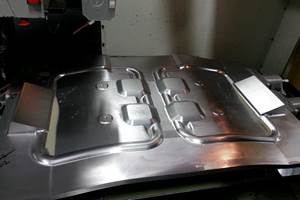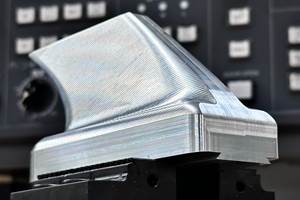Training CNC Operators
Make sure shop newcomers know these basics before they are trained on the machines.
Share






From a numbers standpoint, the position of CNC operator tends to be the most difficult for companies to keep fully staffed. A product-producing company that has 10 CNC machines and works two shifts may have one or two programmers, three or four setup people, and as many as 15 to 20 operators
For this reason, and because it is becoming increasingly difficult to find and hire experienced CNC operators, more and more companies are finding it necessary to provide on-the-job training for new ones. Here are five prerequisite topics you should make sure a CNC operator understands prior to CNC training.
Shop Safety
First and foremost, you must ensure that newcomers to the shop environment understand and can deal with the dangers that exist in any machine shop. For example, be sure they know the location of safety equipment (first-aid kits, fire extinguishers, etc.) as well as how to use this equipment. Be sure they wear appropriate safety gear (eye protection, steel-toed shoes, ear plugs, and so on) and dress appropriately for your shop. Explain safe shop practices (workpiece and raw material handling, getting around, your policy on horseplay and expectations for professional behavior). Be sure they understand specific dangers that exist on the machines they will be running. Truly, anything that affects their safety and the safety of others is fair game for your safety training.
Shop Math
If you expect your CNC operators to make sizing adjustments, they will be performing calculations on a very regular basis. Admittedly, most calculations they make will be simple, involving nothing more than addition and subtraction. But they
must be able to make those simple calculations over and over again, without making mistakes. Be sure operators have (and can use) an appropriate electronic calculator that has large keys
and a large display. Have them minimize advanced functions that can confuse them and lead to mistakes. Be sure the calculator is battery-powered, since there may not be enough light
in their working environment for a solar-powered calculator.
Blueprint Reading
CNC operators must be able to interpret the documentation you provide. In almost all
companies, this documentation includes a blueprint for the workpiece being machined. While they may not be required to visualize a three-dimensional workpiece from a series of two-dimensional views (they will have a finished workpiece to help them), the operators must be able to identify key dimensions and tolerances for the workpieces being machined on the equipment they run.
It may be possible for most new CNC operators to quickly learn blueprint reading skills for simple workpieces, but if your workpieces are more complex, your workpiece drawings will be, too. With complex work, consider providing simpler process drawings that limit the information provided to the workpiece attributes for which the operator is responsible.
Tolerance Interpretations
Limit the initial training for new CNC operators to tolerances for the workpiece attributes they will be sizing. In most cases, these will be dimensional tolerances as opposed to geometric or surface-relationship tolerances. If possible, also limit the types of dimensional tolerances they must interpret. It can be very confusing for new operators to try and learn plus-or-minus, unidirectional and bidirectional tolerances all at one time, although, admittedly, many companies must work with all three. Regardless of the tolerancing methods, be sure the new operators can come up with the high limit, low limit and mean value for any dimension and tolerance.
Be sure they understand the impact of tool wear on the workpiece attributes being machined (that internal surfaces, like holes, will tend to shrink as tools wear, while external surfaces will tend to grow). They must also know when a sizing adjustment is necessary. In addition, be sure they know the target dimension for sizing adjustments they must make. The operators must know what they are shooting for when making a sizing adjustment.
Measuring Devices
CNC operators must be able to measure the workpiece attributes being machined by the equipment they run. They must be able to accurately determine the current size of a workpiece attribute before any sizing decisions can be made, and you must ensure that they master the use of the measuring devices involved. Most operators are regularly required to use variable gages like micrometers and calipers, so they make a pretty good starting point. If your operators must use special measuring devices, like dedicated bore diameter gages, you must provide training on those devices as well.
It’s important to address all of these topics before you even begin actual CNC training to adequately prepare new operators to begin work in your shop.
Related Content
4 Tips for Staying Profitable in the Face of Change
After more than 40 years in business, this shop has learned how to adapt to stay profitable.
Read MoreCustom Workholding Principles to Live By
Workholding solutions can take on infinite forms and all would be correct to some degree. Follow these tips to help optimize custom workholding solutions.
Read MoreHow to Mitigate Risk in Your Manufacturing Process or Design
Use a Failure Mode and Effect Analysis (FMEA) form as a proactive way to evaluate a manufacturing process or design.
Read MoreObscure CNC Features That Can Help (or Hurt) You
You cannot begin to take advantage of an available feature if you do not know it exists. Conversely, you will not know how to avoid CNC features that may be detrimental to your process.
Read MoreRead Next
AMRs Are Moving Into Manufacturing: 4 Considerations for Implementation
AMRs can provide a flexible, easy-to-use automation platform so long as manufacturers choose a suitable task and prepare their facilities.
Read MoreLast Chance! 2025 Top Shops Benchmarking Survey Still Open Through April 30
Don’t miss out! 91ÊÓƵÍøÕ¾ÎÛ's Top Shops Benchmarking Survey is still open — but not for long. This is your last chance to a receive free, customized benchmarking report that includes actionable feedback across several shopfloor and business metrics.
Read MoreMachine Shop MBA
Making Chips and 91ÊÓƵÍøÕ¾ÎÛ are teaming up for a new podcast series called Machine Shop MBA—designed to help manufacturers measure their success against the industry’s best. Through the lens of the Top Shops benchmarking program, the series explores the KPIs that set high-performing shops apart, from machine utilization and first-pass yield to employee engagement and revenue per employee.
Read More.jpg;width=70;height=70;mode=crop)






















